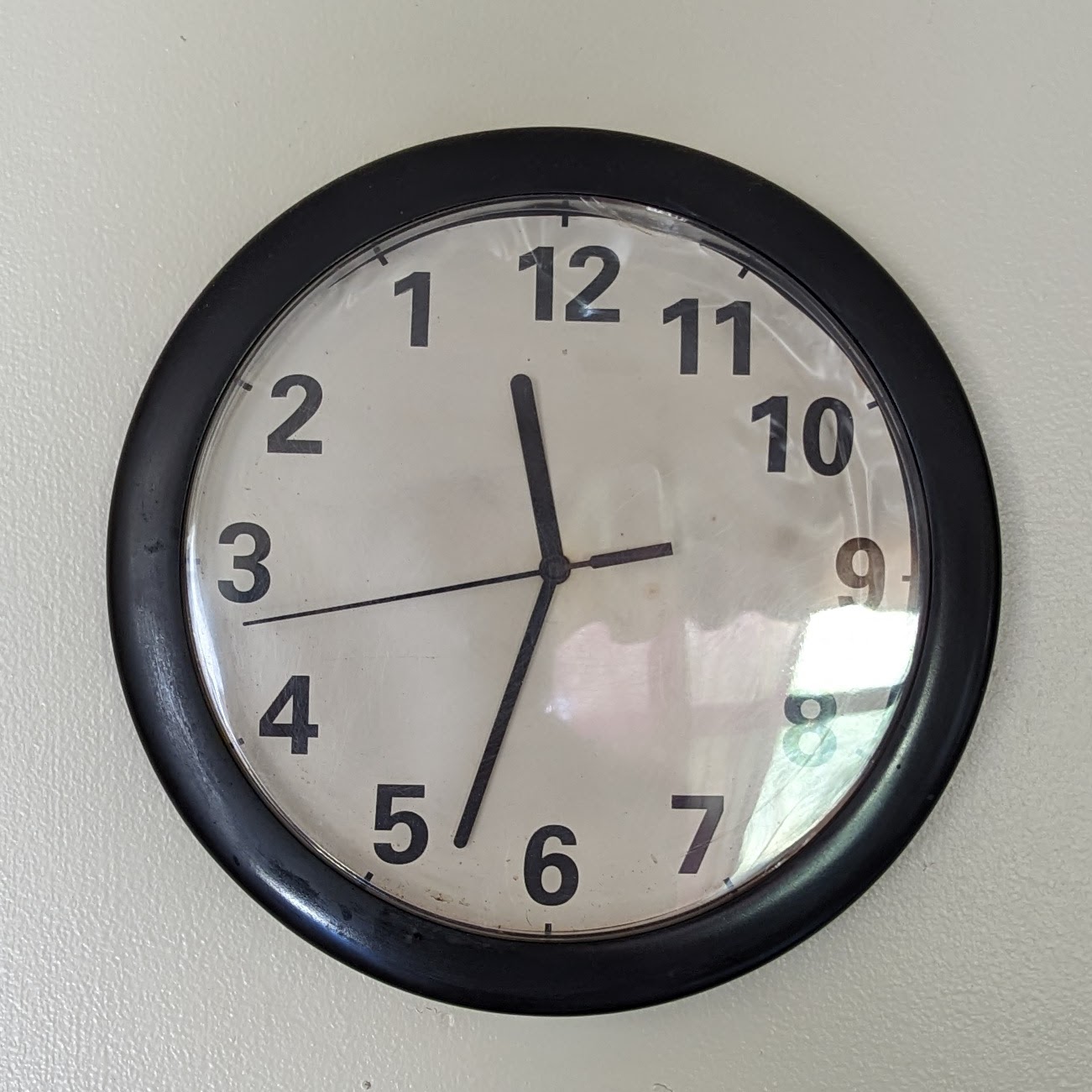Was there an alternative adjective to “clockwise” other than “the rotation you take around left hand”?
Also, how did all watch companies around the world agree on what the direction of “clockwise” is?
A guy I know owns this clock, which basically proves that everything in life is pointless and arbitrary:

I find this deeply unsettling, please delete
I might be evil because now I want a clock like that only with the 1 starting where the 4 is.
I don’t think you’re evil, but there is definitely something wrong with you. lol
It wouldn’t be that hard. Once you get a clock like this with the reverse movement, you can just open the face glass, remove the hands, and print a new graphic for the background.
As a kid, I had a Goofy watch that was like this.
Exactly like this one: https://www.ebay.com/itm/134256287724
Weird, this feels easier to read. Less grating somehow.
You left-handed?
Nope. Right handed. But AuDHD like there’s no tomorrow…
I guess you’re ok. I’m more of an ass man, myself, but I’ll allow it.
Thank you arse lover
I have one of these, it was a gag gift from a friend. I’ve had it up so long now though I have to double check which clock in looking at before I tell the time because I’ve got so used to it
That’s pretty cool. Also, your username contains an anagram of the name of the man who owns the clock from my comment. That’s also pretty cool.
Turnwise and widdershins. I read it in a book once.
Was it Name of the Wind or Wise Man’s Fear? I just read both of those and I remember looking up one of the words and going down a Wikipedia rabbit hole.
Good question!
The real answer seems to be “right” and “left”.
Imagine you’re in the Northern Hemisphere and you face east toward the rising sun. Over the course of the day, the sun will seem to move to the south, and then set in the west. This forms a “sunwise” turn, which is what we now call “clockwise” because we made clocks in imitation of sundials.
As someone who still confuses these “turn it around that way” - jiggles hand in vague motion- “oops no the other way” usually works just fine.
In czech, we have a phrase “jak sa kráje chleba” (same way as a bread is sliced). Problem is, that (at least in my social group) nobody knows, wether it means clockwise or anticlockwise, as everybody slices the bread differently.
same way as a bread is sliced
Haha interesting, but how do you slice bread by rotation? it’s up to down. That’s how you cut stuff.
- Grip the bread vertically to your chest.
- Start cutting in direction from the front to the back.
- Slowly rotate the bread, so you cut the crust only in one point (the tip of the knive moves through already cut bread).
It may be easier to see it with a short knive.
Semi related: QI uploaded this bit the other day about an aboriginal tribe that can flawlessly pinpoint north/east/south/west.
Cardinal directions as references instead of left/right are often a better option when describing locations, more people should use them. It’s not like it’s hard to get an idea of where north is - even if you’re a bit challenged on the spatial awareness front basically everyone these days has a phone that will easily tell you this.
I think saying “keep turning the component to the west” wouldn’t really work.
There are obviously exceptions, hence why I said often instead of always. Think larger scale and/or involving fixed objects and cardinal directions tend to be logical, for example:
-
Install the equipment in the western plant room.
-
Please set up the workstation near the power point on the western wall of the room.
-
Come in via Foo Rd, when you get to the intersection with Bar Rd turn west.
-
My desk is in the south western corner of the office.
-
Walk west along the ridge from the carpark, then once you reach the giant boulder take the northern spur down to the river.
-
I have the feeling that the direction of the water in the toilet when flushing plays an important role here.
Ah yes, turdwise and widdershits as it was known in the olden days, before the invention of sundials
The first mechanical clocks were invented around 1300. The first flushing toilet was 1775.
Yup. That’s definitely “down”.
deleted by creator
I don’t have an answer for the original question, but what about just saying rotate right/left?
I mean, if I imagine a circle rolling on a flat surface, rotating right means the rotation that rolls the circle right (so clockwise rotation), and rotating left would be the opposite; where the circle rolls left.
It works, but it’s ambiguous. You have to specify which part you’re referring to if you want to be sure you’re understood.
You have to specify which part you’re referring to
What do you mean by that?
Turning right, looking at the top of the clock, is different from turning right while looking at the bottom of the clock. And so on.
You’re not entirely wrong, but the convention is to refer to the top of the wheel. But you could be looking at the wheel from the other side, which would change its direction from your perspective.
That’s true, but saying clockwise/anticlockwise also works with fixed perspective, unless the thing itself has a fixed orientation. but if that’s the case, left/right works the same.
No, it’s an extra level of confusion. Clockwise/counterclockwise only has one axis of confusion (looking from front or behind) with one option being the obvious default. Left/right have this axis AND the axis of top/bottom for confusion. It’s literally one bit more ambiguous.
No matter which direction a ball rolls, part of it moves to the right, and part to the left (either top right and bottom left, or vice versa). If you don’t specify which part of the ball you’re looking at, it could be either top or bottom, so the statement is ambiguous.
but without this information, clockwise and anticlockwise also ambigous.
No, they are well-defined. There is no missing information in “clockwise”. There is missing information in “right”.
There is no “top clockwise” or “bottom clockwise”.
What if the wheel is fixed to a frame and it moves a sheet above it like a conveyor system? Is the frame of reference the direction the sheet moves or is it how the wheel moves against the sheet? What if the sheet is below it like a pasta machine or sheet metal former? That being said, “right tightly, lefty loosey” has certainly prevailed
It is a non-existing problem, because they were talking in other languages then.



